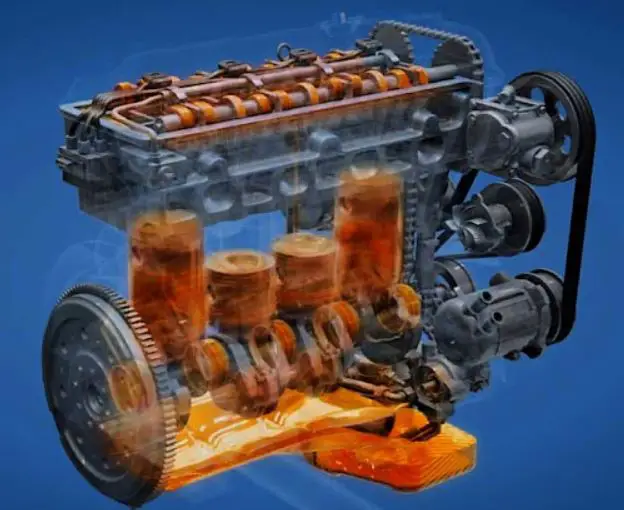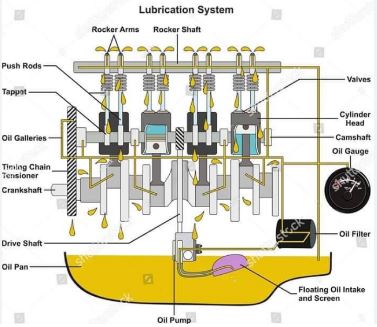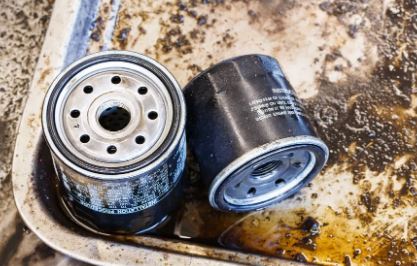If you’re wondering Which Engine Component Stores Oil for Lubrication or which component of your engine is responsible for storing oil and providing lubrication to the moving parts, you’ve come to the right place. Proper lubrication is crucial for the smooth operation and longevity of your engine, and understanding the key components involved is essential for any car owner. Here, we’ll explore the engine component that stores oil for lubrication and its importance in keeping your engine running smoothly.
The Lubrication System of an Engine: Understanding its Parts and Functions

The lubrication system is an essential component of any engine, ensuring that all moving parts are adequately lubricated to prevent wear and tear, overheating, and engine failure. Without proper lubrication, your engine’s components can rub against each other, causing friction, heat, and damage over time. In this article, we will give you an overview of the lubrication system in an engine and explain the different parts that make it up.
Overview of the Lubrication System in an Engine
The primary function of the lubrication system is to provide oil to the engine’s moving parts. When the engine is running, it generates a lot of heat due to the friction between its various components. The lubrication system’s job is to help dissipate this heat by providing a thin layer of oil to the components that need it.
The lubrication system comprises several parts, including the oil pump, oil filter, oil pan, oil pressure gauge, and oil passages. Each of these parts plays a vital role in ensuring that the engine has a constant supply of clean oil.
Explanation of the Different Parts of the Lubrication System

- Oil Pump: The oil pump is responsible for pumping oil through the engine. It is typically located at the bottom of the engine and is driven by the crankshaft. The oil pump creates pressure in the system, which forces oil through the engine’s passages.
- Oil Filter: The oil filter is responsible for removing contaminants from the oil. Over time, oil can become contaminated with dirt, dust, and other debris. The oil filter removes these contaminants, ensuring that only clean oil circulates through the engine.
- Oil Pan: The oil pan is located at the bottom of the engine and serves as a reservoir for oil. It is also designed to catch any debris or metal particles that may have entered the system.
- Oil Pressure Gauge: The oil pressure gauge is responsible for monitoring the oil pressure in the engine. If the oil pressure drops below a certain level, the gauge will alert the driver that there may be a problem with the lubrication system.
- Oil Passages: The oil passages are a network of channels that allow oil to flow through the engine and lubricate the various components. These passages are carefully designed to ensure that oil is delivered to every part of the engine that needs it.
Components of the Lubrication System: Understanding Their Roles and Importance
The lubrication system is an essential component of any engine, ensuring that all moving parts are adequately lubricated to prevent wear and tear, overheating, and engine failure. In this article, we will discuss the different components of the lubrication system and explain their roles in keeping your engine running smoothly.
Oil Pump: Explanation of the Role of the Oil Pump in the Lubrication System
The oil pump is responsible for pumping oil through the engine. It creates pressure in the system, which forces oil through the engine’s passages, ensuring that all moving parts are properly lubricated. Without the oil pump, the lubrication system would not function correctly, leading to engine damage and failure.
Different Types of Oil Pumps
There are two main types of oil pumps – gear pumps and rotor pumps. Gear pumps have two interlocking gears that rotate to pump the oil. Rotor pumps, on the other hand, use a rotor and vanes to move the oil. Gear pumps are more common in most engines, but some high-performance engines use rotor pumps.
Importance of Maintaining the Oil Pump

Regular maintenance is crucial for keeping the oil pump in good condition. A faulty oil pump can cause oil pressure to drop, leading to engine damage or failure. Regular oil changes, replacing worn-out parts, and checking for leaks are some of the ways to maintain the oil pump.
Oil Pan: The Role of the Oil Pan in the Lubrication System
The oil pan is located at the bottom of the engine and serves as a reservoir for oil. It collects oil that has passed through the engine and directs it back to the oil pump. The oil pan also helps to dissipate heat, which keeps the engine cool and prevents overheating.
Oil Pan’s Location in the Engine
The oil pan is typically located at the bottom of the engine and is bolted to the engine block. It is easily accessible from underneath the vehicle and can be removed for maintenance or replacement.
Oil Pan’s Design and Function
The oil pan is designed to catch any debris or metal particles that may have entered the system. It is also designed to allow oil to flow smoothly through the engine, ensuring that all components are adequately lubricated.
Oil Filter: The Role of the Oil Filter in the Lubrication System

The oil filter is responsible for removing contaminants from the oil. Over time, oil can become contaminated with dirt, dust, and other debris, which can cause damage to the engine. The oil filter removes these contaminants, ensuring that only clean oil circulates through the engine.
Different Types of Oil Filters
There are two main types of oil filters – spin-on filters and cartridge filters. Spin-on filters are the most common and are easily replaced. Cartridge filters are less common and require more effort to replace.
Importance of Replacing the Oil Filter Regularly
Regularly replacing the oil filter is essential for keeping the engine running smoothly. A clogged or worn-out oil filter can cause a drop in oil pressure, leading to engine damage or failure. Manufacturers recommend replacing the oil filter with every oil change.
Oil Cooler: Explanation of the Role of the Oil Cooler in the Lubrication System
The oil cooler is responsible for dissipating heat from the engine oil. It helps to keep the oil at the correct temperature, ensuring that it remains effective at lubricating the engine’s components.
Types of Oil Coolers
There are two main types of oil coolers – air-cooled and liquid-cooled. Air-cooled oil coolers are typically smaller and less expensive, but they are less effective at dissipating heat. Liquid-cooled oil coolers are larger and more efficient at dissipating heat, but they are more expensive.
Importance of Maintaining the Oil Cooler
Proper maintenance of the oil cooler is essential for keeping the engine running smoothly. A faulty oil cooler can cause the engine oil to overheat, leading to engine damage or failure. Regularly checking the oil cooler for leaks, clogs, or other issues can help prevent these problems.
Oil Lines: Explanation of the Role of the Oil Lines in the Lubrication System
The oil lines are responsible for carrying oil from the oil pump to the different parts of the engine that require lubrication. They are typically made of metal or rubber and can become damaged over time.
Types of Oil Lines
There are two main types of oil lines – pressure lines and return lines. Pressure lines carry oil from the oil pump to the engine, while return lines carry oil from the engine back to the oil pan.
Importance of Checking and Replacing Damaged Oil Lines
Damaged oil lines can cause oil leaks, which can lead to engine damage or failure. Regularly checking the oil lines for leaks, cracks, or other damage can help prevent these issues. It is also important to replace damaged oil lines as soon as possible.
The Oil Sump: Explanation of the Oil Sump’s Role in Storing Oil for Lubrication
The oil sump is a reservoir that holds the engine oil. It is typically located at the bottom of the engine and is connected to the oil pump. The oil sump’s primary function is to store oil for lubrication purposes.
Description of the Oil Sump’s Location in the Engine
The oil sump is typically located at the bottom of the engine, directly below the crankshaft. It is easily accessible from underneath the vehicle and can be removed for maintenance or replacement.
Explanation of the Oil Sump’s Design and Function
The oil sump is designed to hold a specific amount of oil, ensuring that there is always enough oil available for lubrication. It also contains an oil level sensor, which alerts the driver when the oil level is low.
Importance of Maintaining the Oil Sump
Proper maintenance of the oil sump is essential for keeping the engine running smoothly. A damaged or worn-out oil sump can cause oil leaks or insufficient oil pressure, leading to engine damage or failure. Regularly checking the oil sump for leaks, cracks, or other damage can help prevent these issues.
The lubrication system is a critical component of any engine, and understanding its various parts and functions is essential for proper maintenance and preventing engine damage or failure. Regular maintenance of the oil pump, oil pan, oil filter, oil cooler, oil lines, and oil sump can help ensure that your engine runs smoothly for years to come.
FAQs About Which Engine Component Stores Oil for Lubrication
What happens if an engine runs out of oil?
If an engine runs out of oil, it can cause serious damage to the engine parts, such as the bearings and pistons, which can result in expensive repairs or even engine replacement.
How often should I change the oil in my engine?
It is recommended to change the engine oil every 5,000 to 7,500 miles or as per the manufacturer’s recommendations. However, it may vary based on vehicle usage and the type of oil used.
Can I use any type of oil in my engine?
No, you cannot use any type of oil in your engine. Always refer to the owner’s manual or consult with a professional mechanic to determine the appropriate oil type and viscosity for your specific engine.
What happens if the oil pump fails?
If the oil pump fails, it can cause a lack of oil pressure, leading to engine damage, reduced performance, and ultimately engine failure.
How can I tell if my engine has low oil pressure?
The warning signs of low oil pressure include the oil pressure gauge indicating low pressure, engine noise, engine misfires, and engine warning lights on the dashboard.
Can a clogged oil filter cause engine damage?
Yes, a clogged oil filter can cause engine damage as it restricts the flow of oil to the engine, leading to engine wear, overheating, and potential engine failure.
How do I check the oil level in my engine?
Check the oil level by pulling out the dipstick, wiping it clean, and reinserting it. Then, pull it out again and look at the oil level indicator on the dipstick to determine if it is within the recommended range.
Conclusion
Oil is a vital component in lubricating the engine and ensuring it functions properly. The oil sump plays a crucial role in storing oil for lubrication, and it is supported by several other components in the lubrication system, including the oil pump, oil pan, oil filter, oil cooler, and oil lines. To prevent engine damage and ensure optimal engine performance, it is crucial to regularly maintain and replace these components as recommended by the manufacturer or a professional mechanic.
Related Topics:
- How Long to Let Engine Cool Before Adding Oil
- Oil Change Check Engine Light
- Which Engine Component Stores Oil for Lubrication
- How To Remove Oil Pan Without Removing Engine
- Is It Ok to Change Engine Oil Brands
- How Much Oil Should a Car Burn Between Oil Changes
- Is Lucas Oil Stabilizer Good for Your Engine
- what will happen if i don’t use dexos oil


